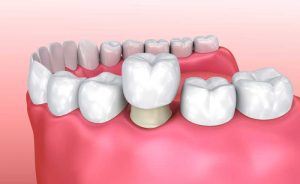By Dr. Salina Suy
Editor’s note: This is another segment in a continuing series titled “Defining Dentistry,” designed to enlighten readers on various components of dentistry.
In this month’s column, we are continuing our Defining Dentistry series with new knowledge on dental crowns.
You may have heard someone you know talk about crowns before, commonly known as caps. Crowns are a great definitive restoration to prevent teeth from fracturing.
What is a crown?
A crown or cap is a type of dental restoration that overlies or encircles a tooth or dental implant. Crowns can be on a single tooth or implant, as part of a bridge or as an anchor for a partial denture.
Crowns are often needed when a large existing filling or large cavity endangers the health of the tooth. Crowns help prevent fracture of healthy teeth and are very important for root canal-treated teeth since they become brittle over time.
If teeth are going to be anchors for partials or a bridge, the crown will help protect that tooth during the stress of anchoring your dental prosthesis. In some cases, crowns may be used to change a patient’s smile.
The first step to getting a crown is proper diagnosing. If teeth require root canal treatment or a crown-core buildup, these procedures should be done before a crown prep, if possible. A crown-core buildup is the foundation of the tooth that the crown will be placed upon.
Once the tooth is ready, the tooth is then “prepped” to make room for the material that is going to make the crown. Once the crown prep is complete, an impression is taken. Impressions can be made with impression material or digitally scanned.
From the impressions, we will make the crown to fit your tooth and it will be cemented on.
Depending on your dentist, your crown may take one hour to two weeks; treatment time varies with office technology.
While crown impressions are sent out to a lab, the tooth needs to be covered with a temporary crown for your protection since it takes about two weeks to make.
Crown impressions that are captured and fabricated in office will take about two hours. Both are good restorations. Crowns are made of many different materials — they can be made of metal, porcelain and a combination of both.
Crowns are a great way to protect your teeth. Historically, older generations may need more crowns since dental medicine was once very aggressive; we find many large fillings result in fracture. Modern dentists are now much more conservative than that of our older counterparts.


 2607 Genesee St., Utica, NY 13501
2607 Genesee St., Utica, NY 13501  315-724-3197
315-724-3197